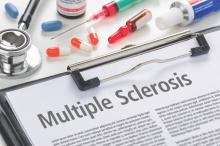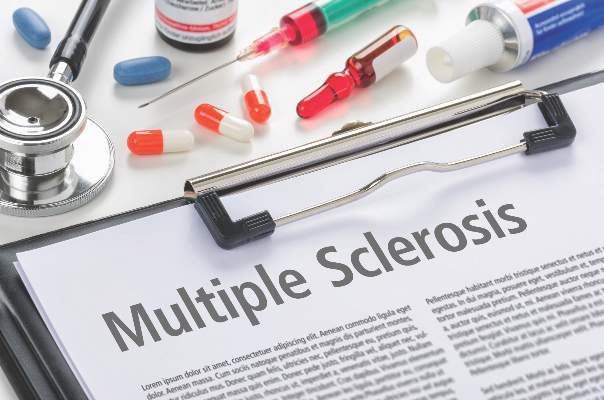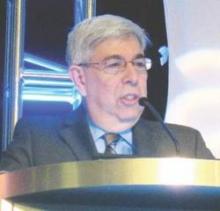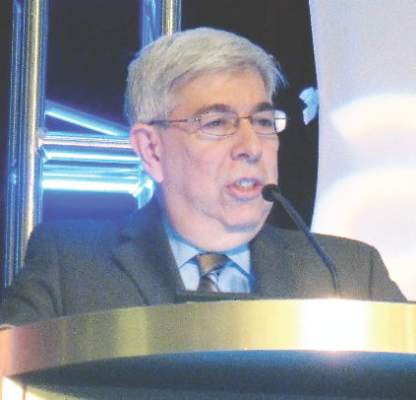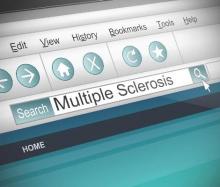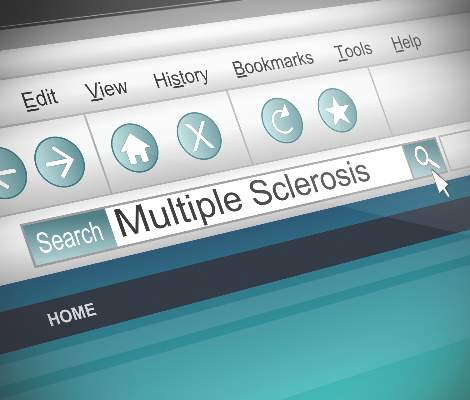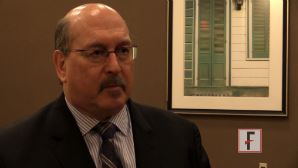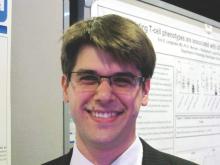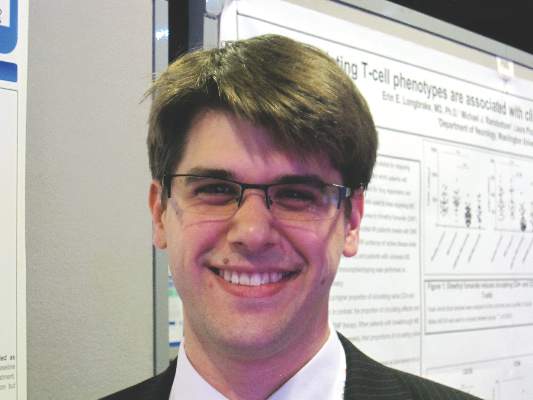User login
Evidence builds for mesenchymal stem cell therapy in MS
NEW ORLEANS – Repeated intrathecal administration of autologous mesenchymal bone marrow-derived stromal stem cells for the treatment of multiple sclerosis was safe and induced accelerated beneficial effects in some patients in an uncontrolled, prospective study.
Of 28 patients with either secondary progressive or relapsing-progressive MS who were experiencing severe clinical deterioration and failure to respond to first- and second-line immunomodulatory treatments, 25 experienced either stable or improved Expanded Disability Status Scale (EDSS) scores following autologous mesenchymal stem cell (MSC) injections. The mean score decreased from 6.76 at study entry to 6.57 at a mean follow-up of 3.6 years, Dr. Panayiota Petrou of Hadassah-Hebrew University Medical Center, Jerusalem, Israel, and her colleagues reported in a poster at a meeting held by the Americas Committee for Treatment and Research in Multiple Sclerosis.
In addition, 17 patients experienced improvements in at least one functional system of the EDSS, including 14 who experienced improved motor function, 5 who experienced improved speech/bulbar functions, 4 who experienced improved urinary functions, and 6 who experienced improved cerebellar function. Eight patients remained stable during the entire follow-up period.
In a prior pilot trial, intrathecal administration of MSCs was shown to be safe and provided “some indications of potentially clinically meaningful beneficial effects on the progression of the disease,” the investigators said.
The current study provides further support for those findings. It included patients who experienced severe clinical deterioration (at least 0.5-1 points in the EDSS) during the year prior to study enrollment, or who had at least one major relapse without sufficient recovery following steroid treatment. Study subjects had a mean age of 56 years and mean disease duration of 15.4 years. They received at least 2 courses and up to 10 injections with 1 million cells/kg; most received 2 (8 patients) or 3 (9 patients) injections, and they were followed for up to 6 years.
No serious side effects were observed during long-term follow-up after repeated intrathecal injections. Eight patients experienced headaches and/or fever in the hours and days after injection, and two experienced symptoms of encephalopathy, which resolved within a few hours. Also, one patient experienced back pain and one had neck rigidity, but no long-term side effects were reported, the investigators said.
Immunological follow-up showed a transient up-regulation of regulatory T cells and down-regulation of the proliferative ability of lymphocytes and of several immune activation surface markers for up to 3 months, they noted.
The investigators reported having no disclosures.
NEW ORLEANS – Repeated intrathecal administration of autologous mesenchymal bone marrow-derived stromal stem cells for the treatment of multiple sclerosis was safe and induced accelerated beneficial effects in some patients in an uncontrolled, prospective study.
Of 28 patients with either secondary progressive or relapsing-progressive MS who were experiencing severe clinical deterioration and failure to respond to first- and second-line immunomodulatory treatments, 25 experienced either stable or improved Expanded Disability Status Scale (EDSS) scores following autologous mesenchymal stem cell (MSC) injections. The mean score decreased from 6.76 at study entry to 6.57 at a mean follow-up of 3.6 years, Dr. Panayiota Petrou of Hadassah-Hebrew University Medical Center, Jerusalem, Israel, and her colleagues reported in a poster at a meeting held by the Americas Committee for Treatment and Research in Multiple Sclerosis.
In addition, 17 patients experienced improvements in at least one functional system of the EDSS, including 14 who experienced improved motor function, 5 who experienced improved speech/bulbar functions, 4 who experienced improved urinary functions, and 6 who experienced improved cerebellar function. Eight patients remained stable during the entire follow-up period.
In a prior pilot trial, intrathecal administration of MSCs was shown to be safe and provided “some indications of potentially clinically meaningful beneficial effects on the progression of the disease,” the investigators said.
The current study provides further support for those findings. It included patients who experienced severe clinical deterioration (at least 0.5-1 points in the EDSS) during the year prior to study enrollment, or who had at least one major relapse without sufficient recovery following steroid treatment. Study subjects had a mean age of 56 years and mean disease duration of 15.4 years. They received at least 2 courses and up to 10 injections with 1 million cells/kg; most received 2 (8 patients) or 3 (9 patients) injections, and they were followed for up to 6 years.
No serious side effects were observed during long-term follow-up after repeated intrathecal injections. Eight patients experienced headaches and/or fever in the hours and days after injection, and two experienced symptoms of encephalopathy, which resolved within a few hours. Also, one patient experienced back pain and one had neck rigidity, but no long-term side effects were reported, the investigators said.
Immunological follow-up showed a transient up-regulation of regulatory T cells and down-regulation of the proliferative ability of lymphocytes and of several immune activation surface markers for up to 3 months, they noted.
The investigators reported having no disclosures.
NEW ORLEANS – Repeated intrathecal administration of autologous mesenchymal bone marrow-derived stromal stem cells for the treatment of multiple sclerosis was safe and induced accelerated beneficial effects in some patients in an uncontrolled, prospective study.
Of 28 patients with either secondary progressive or relapsing-progressive MS who were experiencing severe clinical deterioration and failure to respond to first- and second-line immunomodulatory treatments, 25 experienced either stable or improved Expanded Disability Status Scale (EDSS) scores following autologous mesenchymal stem cell (MSC) injections. The mean score decreased from 6.76 at study entry to 6.57 at a mean follow-up of 3.6 years, Dr. Panayiota Petrou of Hadassah-Hebrew University Medical Center, Jerusalem, Israel, and her colleagues reported in a poster at a meeting held by the Americas Committee for Treatment and Research in Multiple Sclerosis.
In addition, 17 patients experienced improvements in at least one functional system of the EDSS, including 14 who experienced improved motor function, 5 who experienced improved speech/bulbar functions, 4 who experienced improved urinary functions, and 6 who experienced improved cerebellar function. Eight patients remained stable during the entire follow-up period.
In a prior pilot trial, intrathecal administration of MSCs was shown to be safe and provided “some indications of potentially clinically meaningful beneficial effects on the progression of the disease,” the investigators said.
The current study provides further support for those findings. It included patients who experienced severe clinical deterioration (at least 0.5-1 points in the EDSS) during the year prior to study enrollment, or who had at least one major relapse without sufficient recovery following steroid treatment. Study subjects had a mean age of 56 years and mean disease duration of 15.4 years. They received at least 2 courses and up to 10 injections with 1 million cells/kg; most received 2 (8 patients) or 3 (9 patients) injections, and they were followed for up to 6 years.
No serious side effects were observed during long-term follow-up after repeated intrathecal injections. Eight patients experienced headaches and/or fever in the hours and days after injection, and two experienced symptoms of encephalopathy, which resolved within a few hours. Also, one patient experienced back pain and one had neck rigidity, but no long-term side effects were reported, the investigators said.
Immunological follow-up showed a transient up-regulation of regulatory T cells and down-regulation of the proliferative ability of lymphocytes and of several immune activation surface markers for up to 3 months, they noted.
The investigators reported having no disclosures.
AT ACTRIMS FORUM 2016
Key clinical point: Repeated intrathecal administration of autologous mesenchymal bone marrow–derived stromal stem cells stabilized or improved EDSS scores in most MS patients at up to 6 years of follow-up.
Major finding: The mean EDSS score decreased from 6.76 at study entry to 6.57 at a mean follow-up of 3.6 years.
Data source: An uncontrolled, prospective study involving 28 MS patients.
Disclosures: The investigators reported having no disclosures.
Study examines efficacy of small group programs for fatigue in MS
NEW ORLEANS – Fatigue: Take Control (FTC), a 6-week group education and behavioral program widely used to address fatigue in patients with multiple sclerosis, was comparable to a general MS education program for decreasing fatigue and improving self-efficacy in a randomized, controlled study.
In 218 subjects randomized to participate in either FTC or a general MS education program (MS: Take Control, or MSTC), Modified Fatigue Impact Scale scores improved significantly, compared with baseline and regardless of group assignment; there was no difference between the groups at visit 6 (mean change, –4.5 and –3.6 in the FTC and MSTC groups, respectively), Cinda L. Hugos of the VA Portland (Ore.) Health Care System and her colleagues reported at a meeting held by the Americas Committee for Treatment and Research in Multiple Sclerosis.
Multiple Sclerosis Self-Efficacy scale scores did, however, improve significantly in the FTC group vs. the MSTC group (mean increase of 45.5 vs. a decrease of 15.8), but the improvement was not maintained at 6 months, the investigators reported in a poster at the meeting.
The two groups had comparable baseline characteristics, with a mean age of nearly 54 years, as well as similar mean time since diagnosis (12.5 years), self-administered Expanded Disability Status Scale scores (5.2), and demographics.
Fatigue is common in MS patients, occurring in up to 95% of patients, and many report that it is the most disabling symptom. FTC, which addresses medical management of fatigue, exercise, environment, and changes and choices with respect to energy and fatigue control, is often used by chapters of the National MS Society, but its effectiveness for decreasing fatigue or improving self-efficacy has not been proven, the investigators noted.
To determine if FTC decreases fatigue and increases self-efficacy, compared with a general MS education program that addresses issues such as nutrition, emotional health, cognitive problems, and fitness, the investigators randomized subjects at four sites in groups of between 3 and 10 participants to either an FTC or MSTC group. All subjects had moderate to severe fatigue. Those with pregnancy, severe depression, uncontrolled problems that would limit participation, relapse in the prior month, or initiation of a new disease-modifying treatment within the prior 3 months were excluded.
“Both FTC and MSTC structured small group programs were associated with improved self-reported fatigue at program completion and at 3- and 6-month follow-up, but there were no significant differences in fatigue scores between FTC and MSTC participants at any time point,” the investigators wrote.
Self-efficacy was significantly better among FTC participants at program completion, but was not sustained, they noted, concluding that the findings suggest that “participating in structured small group programs is associated with prolonged reductions in fatigue in people with MS and that supporting goal setting provides short-term improvements in self-efficacy.”
Further research is needed to determine whether booster sessions would be beneficial for sustaining improvements in self-efficacy, they added.
This study was supported by the Rehabilitation, Research, & Development Service of the Veterans Affairs Office of Research & Development. The authors reported having no disclosures.
NEW ORLEANS – Fatigue: Take Control (FTC), a 6-week group education and behavioral program widely used to address fatigue in patients with multiple sclerosis, was comparable to a general MS education program for decreasing fatigue and improving self-efficacy in a randomized, controlled study.
In 218 subjects randomized to participate in either FTC or a general MS education program (MS: Take Control, or MSTC), Modified Fatigue Impact Scale scores improved significantly, compared with baseline and regardless of group assignment; there was no difference between the groups at visit 6 (mean change, –4.5 and –3.6 in the FTC and MSTC groups, respectively), Cinda L. Hugos of the VA Portland (Ore.) Health Care System and her colleagues reported at a meeting held by the Americas Committee for Treatment and Research in Multiple Sclerosis.
Multiple Sclerosis Self-Efficacy scale scores did, however, improve significantly in the FTC group vs. the MSTC group (mean increase of 45.5 vs. a decrease of 15.8), but the improvement was not maintained at 6 months, the investigators reported in a poster at the meeting.
The two groups had comparable baseline characteristics, with a mean age of nearly 54 years, as well as similar mean time since diagnosis (12.5 years), self-administered Expanded Disability Status Scale scores (5.2), and demographics.
Fatigue is common in MS patients, occurring in up to 95% of patients, and many report that it is the most disabling symptom. FTC, which addresses medical management of fatigue, exercise, environment, and changes and choices with respect to energy and fatigue control, is often used by chapters of the National MS Society, but its effectiveness for decreasing fatigue or improving self-efficacy has not been proven, the investigators noted.
To determine if FTC decreases fatigue and increases self-efficacy, compared with a general MS education program that addresses issues such as nutrition, emotional health, cognitive problems, and fitness, the investigators randomized subjects at four sites in groups of between 3 and 10 participants to either an FTC or MSTC group. All subjects had moderate to severe fatigue. Those with pregnancy, severe depression, uncontrolled problems that would limit participation, relapse in the prior month, or initiation of a new disease-modifying treatment within the prior 3 months were excluded.
“Both FTC and MSTC structured small group programs were associated with improved self-reported fatigue at program completion and at 3- and 6-month follow-up, but there were no significant differences in fatigue scores between FTC and MSTC participants at any time point,” the investigators wrote.
Self-efficacy was significantly better among FTC participants at program completion, but was not sustained, they noted, concluding that the findings suggest that “participating in structured small group programs is associated with prolonged reductions in fatigue in people with MS and that supporting goal setting provides short-term improvements in self-efficacy.”
Further research is needed to determine whether booster sessions would be beneficial for sustaining improvements in self-efficacy, they added.
This study was supported by the Rehabilitation, Research, & Development Service of the Veterans Affairs Office of Research & Development. The authors reported having no disclosures.
NEW ORLEANS – Fatigue: Take Control (FTC), a 6-week group education and behavioral program widely used to address fatigue in patients with multiple sclerosis, was comparable to a general MS education program for decreasing fatigue and improving self-efficacy in a randomized, controlled study.
In 218 subjects randomized to participate in either FTC or a general MS education program (MS: Take Control, or MSTC), Modified Fatigue Impact Scale scores improved significantly, compared with baseline and regardless of group assignment; there was no difference between the groups at visit 6 (mean change, –4.5 and –3.6 in the FTC and MSTC groups, respectively), Cinda L. Hugos of the VA Portland (Ore.) Health Care System and her colleagues reported at a meeting held by the Americas Committee for Treatment and Research in Multiple Sclerosis.
Multiple Sclerosis Self-Efficacy scale scores did, however, improve significantly in the FTC group vs. the MSTC group (mean increase of 45.5 vs. a decrease of 15.8), but the improvement was not maintained at 6 months, the investigators reported in a poster at the meeting.
The two groups had comparable baseline characteristics, with a mean age of nearly 54 years, as well as similar mean time since diagnosis (12.5 years), self-administered Expanded Disability Status Scale scores (5.2), and demographics.
Fatigue is common in MS patients, occurring in up to 95% of patients, and many report that it is the most disabling symptom. FTC, which addresses medical management of fatigue, exercise, environment, and changes and choices with respect to energy and fatigue control, is often used by chapters of the National MS Society, but its effectiveness for decreasing fatigue or improving self-efficacy has not been proven, the investigators noted.
To determine if FTC decreases fatigue and increases self-efficacy, compared with a general MS education program that addresses issues such as nutrition, emotional health, cognitive problems, and fitness, the investigators randomized subjects at four sites in groups of between 3 and 10 participants to either an FTC or MSTC group. All subjects had moderate to severe fatigue. Those with pregnancy, severe depression, uncontrolled problems that would limit participation, relapse in the prior month, or initiation of a new disease-modifying treatment within the prior 3 months were excluded.
“Both FTC and MSTC structured small group programs were associated with improved self-reported fatigue at program completion and at 3- and 6-month follow-up, but there were no significant differences in fatigue scores between FTC and MSTC participants at any time point,” the investigators wrote.
Self-efficacy was significantly better among FTC participants at program completion, but was not sustained, they noted, concluding that the findings suggest that “participating in structured small group programs is associated with prolonged reductions in fatigue in people with MS and that supporting goal setting provides short-term improvements in self-efficacy.”
Further research is needed to determine whether booster sessions would be beneficial for sustaining improvements in self-efficacy, they added.
This study was supported by the Rehabilitation, Research, & Development Service of the Veterans Affairs Office of Research & Development. The authors reported having no disclosures.
AT ACTRIMS FORUM 2016
Key clinical point: Fatigue: Take Control (FTC), a 6-week program widely used to address fatigue in patients with multiple sclerosis, was comparable to a general MS education program for decreasing fatigue and improving self-efficacy in a randomized, controlled study.
Major finding: FTC and a general MS education program improved Modified Fatigue Impact Scale scores significantly, with no difference between the groups at visit 6 (mean change, –4.5 and –3.6 in the groups, respectively).
Data source: A randomized, controlled trial of 218 MS patients.
Disclosures: This study was supported by the Rehabilitation, Research & Development Service of the VA Office of Research and Development. The authors reported having no disclosures.
Stem cell therapy for MS: Steady progress but not ready for general use
NEW ORLEANS – Stem cell-mediated functional regeneration continues to attract interest in the treatment of multiple sclerosis (MS). The reality, however, is daunting.
“Several types of cell-based therapeutic strategies are under investigation, with different risks, benefits, and goals. Some of these strategies show promise but significant methodological questions need to be answered,” Dr. Andrew D. Goodman said at a meeting held by the Americas Committee for Treatment and Research in Multiple Sclerosis.
The present reality is that stem cell transplantation is not yet ready for general use to treat MS. Yet, the possible benefits of the approach demand further exploration, including clinical trials, according to Dr. Goodman, professor of neurology, chief of the neuroimmunology unit, and director of the multiple sclerosis center at the University of Rochester (N.Y.).
MS stem cell therapy hinges on the pluripotent nature of stem cells, particularly mesenchymal stem cells (MSCs) and hematopoietic stem cells. MS therapy would involve regeneration of nerve cell myelin in the brain and/or spinal cord and possibly suppression of inflammation.
Autologous HSC transplantation
Immunoablation followed by the autologous HSC transplantation (HSCT) has been explored in the ASTIMS phase II randomized trials (Neurology. Mar 10;84[10]:981-8 and HALT-MS, JAMA Neurol. 2015 Feb;72[2]:159-69), and in a Northwestern University case series (JAMA. 2015 Jan 20;313[3]:275-84).
ASTIMS compared high-dose chemotherapy followed by autologous HSCT with mitoxantrone (which is no longer used). Only 22% percent of patients had relapsing-remitting MS (RRMS; the one where HSCT generally works) and 78% had primary progressive MS (where HSCT generally does not work well or is not optimal). Yet, HSCT worked, with new T2 lesions reduced by 79%. No difference in disability progression was evident. Interim (3-year) results of HALT-MS were encouraging, with sustained remission of active RRMS and improved neurologic function. The Northwestern case series also documented improvements in neurologic disability and other clinical outcomes.
“The available data suggest that immunoablation and HSCT is highly effective in active RRMS. Patients most likely to benefit are young and still ambulatory with a relatively recent disease onset featuring highly active MS with MRI lesion activity and continued activity despite first- and second-line agents,” Dr. Goodman said.
While encouraging, the small patient numbers of the two trials and uncontrolled nature of the case series prevent conclusions concerning the therapeutic use of autologous HSCT in RRMS. Furthermore, risks of the approach include MS relapse, treatment-related adverse effects, adverse effects due to myelosuppression and immunoablation, and secondary autoimmune disorders that may arise at a later time.
Mesenchymal stem cell transplantation
MSCs offer the advantages of a variety of sources in adult tissue, established methods of culture, and either local or peripheral administration. Their finite capacity for proliferation is a drawback. Studies to date of MSC transplantation in MS have involved about 100 patients, so it is much too early to consider MSC use. Even if therapy is contemplated, whether it should be directed at quelling inflammation or to promote repair is undecided. As well, cell production and delivery issues need to be addressed, Dr. Goodman said.
Human oligodendrocyte progenitor cell transplantation
The implantation of CD 140a+ cell populations containing human oligodendrocyte progenitor cells (hOPCs) into the cerebral hemispheres of patients with non-relapsing secondary progressive MS as a means of stabilizing or improving neurological function is being planned. The NYSTEM project, with Dr. Goodman as a lead investigator, will first seek to identify the maximum tolerated dose of hOPCs.
The study is planned with the knowledge of safety issues that include cancer tumorigenesis. Yet exploration of the possible benefits will be evident only by testing in humans. “I don’t know of any way to find out except by trying,” Dr. Goodman said.
Dr. Goodman disclosed receiving research support and/or serving as a consultant to Avanir, Teva, Genzyme/Sanofi, Sun Pharma, Ono, Roche, AbbVie, Biogen, Novartis, Acorda, Purdue, and EMD Serono.
NEW ORLEANS – Stem cell-mediated functional regeneration continues to attract interest in the treatment of multiple sclerosis (MS). The reality, however, is daunting.
“Several types of cell-based therapeutic strategies are under investigation, with different risks, benefits, and goals. Some of these strategies show promise but significant methodological questions need to be answered,” Dr. Andrew D. Goodman said at a meeting held by the Americas Committee for Treatment and Research in Multiple Sclerosis.
The present reality is that stem cell transplantation is not yet ready for general use to treat MS. Yet, the possible benefits of the approach demand further exploration, including clinical trials, according to Dr. Goodman, professor of neurology, chief of the neuroimmunology unit, and director of the multiple sclerosis center at the University of Rochester (N.Y.).
MS stem cell therapy hinges on the pluripotent nature of stem cells, particularly mesenchymal stem cells (MSCs) and hematopoietic stem cells. MS therapy would involve regeneration of nerve cell myelin in the brain and/or spinal cord and possibly suppression of inflammation.
Autologous HSC transplantation
Immunoablation followed by the autologous HSC transplantation (HSCT) has been explored in the ASTIMS phase II randomized trials (Neurology. Mar 10;84[10]:981-8 and HALT-MS, JAMA Neurol. 2015 Feb;72[2]:159-69), and in a Northwestern University case series (JAMA. 2015 Jan 20;313[3]:275-84).
ASTIMS compared high-dose chemotherapy followed by autologous HSCT with mitoxantrone (which is no longer used). Only 22% percent of patients had relapsing-remitting MS (RRMS; the one where HSCT generally works) and 78% had primary progressive MS (where HSCT generally does not work well or is not optimal). Yet, HSCT worked, with new T2 lesions reduced by 79%. No difference in disability progression was evident. Interim (3-year) results of HALT-MS were encouraging, with sustained remission of active RRMS and improved neurologic function. The Northwestern case series also documented improvements in neurologic disability and other clinical outcomes.
“The available data suggest that immunoablation and HSCT is highly effective in active RRMS. Patients most likely to benefit are young and still ambulatory with a relatively recent disease onset featuring highly active MS with MRI lesion activity and continued activity despite first- and second-line agents,” Dr. Goodman said.
While encouraging, the small patient numbers of the two trials and uncontrolled nature of the case series prevent conclusions concerning the therapeutic use of autologous HSCT in RRMS. Furthermore, risks of the approach include MS relapse, treatment-related adverse effects, adverse effects due to myelosuppression and immunoablation, and secondary autoimmune disorders that may arise at a later time.
Mesenchymal stem cell transplantation
MSCs offer the advantages of a variety of sources in adult tissue, established methods of culture, and either local or peripheral administration. Their finite capacity for proliferation is a drawback. Studies to date of MSC transplantation in MS have involved about 100 patients, so it is much too early to consider MSC use. Even if therapy is contemplated, whether it should be directed at quelling inflammation or to promote repair is undecided. As well, cell production and delivery issues need to be addressed, Dr. Goodman said.
Human oligodendrocyte progenitor cell transplantation
The implantation of CD 140a+ cell populations containing human oligodendrocyte progenitor cells (hOPCs) into the cerebral hemispheres of patients with non-relapsing secondary progressive MS as a means of stabilizing or improving neurological function is being planned. The NYSTEM project, with Dr. Goodman as a lead investigator, will first seek to identify the maximum tolerated dose of hOPCs.
The study is planned with the knowledge of safety issues that include cancer tumorigenesis. Yet exploration of the possible benefits will be evident only by testing in humans. “I don’t know of any way to find out except by trying,” Dr. Goodman said.
Dr. Goodman disclosed receiving research support and/or serving as a consultant to Avanir, Teva, Genzyme/Sanofi, Sun Pharma, Ono, Roche, AbbVie, Biogen, Novartis, Acorda, Purdue, and EMD Serono.
NEW ORLEANS – Stem cell-mediated functional regeneration continues to attract interest in the treatment of multiple sclerosis (MS). The reality, however, is daunting.
“Several types of cell-based therapeutic strategies are under investigation, with different risks, benefits, and goals. Some of these strategies show promise but significant methodological questions need to be answered,” Dr. Andrew D. Goodman said at a meeting held by the Americas Committee for Treatment and Research in Multiple Sclerosis.
The present reality is that stem cell transplantation is not yet ready for general use to treat MS. Yet, the possible benefits of the approach demand further exploration, including clinical trials, according to Dr. Goodman, professor of neurology, chief of the neuroimmunology unit, and director of the multiple sclerosis center at the University of Rochester (N.Y.).
MS stem cell therapy hinges on the pluripotent nature of stem cells, particularly mesenchymal stem cells (MSCs) and hematopoietic stem cells. MS therapy would involve regeneration of nerve cell myelin in the brain and/or spinal cord and possibly suppression of inflammation.
Autologous HSC transplantation
Immunoablation followed by the autologous HSC transplantation (HSCT) has been explored in the ASTIMS phase II randomized trials (Neurology. Mar 10;84[10]:981-8 and HALT-MS, JAMA Neurol. 2015 Feb;72[2]:159-69), and in a Northwestern University case series (JAMA. 2015 Jan 20;313[3]:275-84).
ASTIMS compared high-dose chemotherapy followed by autologous HSCT with mitoxantrone (which is no longer used). Only 22% percent of patients had relapsing-remitting MS (RRMS; the one where HSCT generally works) and 78% had primary progressive MS (where HSCT generally does not work well or is not optimal). Yet, HSCT worked, with new T2 lesions reduced by 79%. No difference in disability progression was evident. Interim (3-year) results of HALT-MS were encouraging, with sustained remission of active RRMS and improved neurologic function. The Northwestern case series also documented improvements in neurologic disability and other clinical outcomes.
“The available data suggest that immunoablation and HSCT is highly effective in active RRMS. Patients most likely to benefit are young and still ambulatory with a relatively recent disease onset featuring highly active MS with MRI lesion activity and continued activity despite first- and second-line agents,” Dr. Goodman said.
While encouraging, the small patient numbers of the two trials and uncontrolled nature of the case series prevent conclusions concerning the therapeutic use of autologous HSCT in RRMS. Furthermore, risks of the approach include MS relapse, treatment-related adverse effects, adverse effects due to myelosuppression and immunoablation, and secondary autoimmune disorders that may arise at a later time.
Mesenchymal stem cell transplantation
MSCs offer the advantages of a variety of sources in adult tissue, established methods of culture, and either local or peripheral administration. Their finite capacity for proliferation is a drawback. Studies to date of MSC transplantation in MS have involved about 100 patients, so it is much too early to consider MSC use. Even if therapy is contemplated, whether it should be directed at quelling inflammation or to promote repair is undecided. As well, cell production and delivery issues need to be addressed, Dr. Goodman said.
Human oligodendrocyte progenitor cell transplantation
The implantation of CD 140a+ cell populations containing human oligodendrocyte progenitor cells (hOPCs) into the cerebral hemispheres of patients with non-relapsing secondary progressive MS as a means of stabilizing or improving neurological function is being planned. The NYSTEM project, with Dr. Goodman as a lead investigator, will first seek to identify the maximum tolerated dose of hOPCs.
The study is planned with the knowledge of safety issues that include cancer tumorigenesis. Yet exploration of the possible benefits will be evident only by testing in humans. “I don’t know of any way to find out except by trying,” Dr. Goodman said.
Dr. Goodman disclosed receiving research support and/or serving as a consultant to Avanir, Teva, Genzyme/Sanofi, Sun Pharma, Ono, Roche, AbbVie, Biogen, Novartis, Acorda, Purdue, and EMD Serono.
EXPERT ANALYSIS FROM ACTRIMS FORUM 2016
Brain atrophy may be a clinically relevant measure in PPMS: Data from INFORMS
NEW ORLEANS – The recently published results of the INFORMS multicenter, double-blind, placebo-controlled parallel-group study (NCT00731692) that compared the efficacy of fingolimod in slowing disease progression in primary progressive multiple sclerosis (PPMS) with placebo proved disappointing. However, further scrutiny of the data has provided valuable insights, such as supportive evidence for brain atrophy as a clinically relevant measure in PPMS patients.
“The degree of clinical worsening was directly associated with patient’s extent of brain volume loss. Patients in the extreme category of disability progression had more brain volume loss than patients with only one progression or those who remained clinically stable,” wrote Dr. Jerry Wolinsky of the University of Texas Health Science Center at Houston and his colleagues in a poster presented Feb. 19 at the meeting held by the Americas Committee for Treatment and Research in Multiple Sclerosis.
In INFORMS, 970 patients with PPMS were randomly allocated (1:1) to receive oral fingolimod 0.5 mg or placebo for at least 36 months and for up to 5 years. The anti-inflammatory effects of fingolimod did not slow disease progression in PPMS.
While INFORMS did not pan out in terms of the primary endpoint, the long duration of the study, use of various progression measures, and rigorous patient selection offered the unique opportunity to assess the associations of magnetic resonance imaging of the brain over at least 3 years of the clinical progression occurring in patients with PPMS.
All patients had being clinically diagnosed with PPMS, with disease duration of 2-10 years and objective evidence of progression in disability in the prior 2 years. The composite endpoint of INFORMS based on the change in Expanded Disability Status Scale (EDSS), 25-Foot Timed Walk Test, or 9-Hole Peg Test was used to gauge 3-month confirmed disease progression (3CDP). The patients were classified according to EDSS-determined disease progression as extreme (more than one occurrence of 3CDP; n = 162), moderate (one occurrence of 3CDP; n = 309), and stable (no 3CDP; n = 499).
Mean age, % male, and baseline EDSS scores were similar across the three categories (whole population: 48.4 ± 8.4 years; 51.6%; and 4.7 ± 1.0, respectively). Mean number of gadolinium-positive lesions in the extreme and stable category was 0.39 ± 1.1 and 0.25 ± 1.0, respectively. Baseline T2 lesion volume was 10,160.8 ± 12,743.3 mm3 in extreme patients and 9,585.8 ± 12,421.6 mm3 in stable patients.
Patients in the extreme category displayed greater changes in the three endpoint measures than did the moderate and stable categories. At month 36, the mean change in brain volume, compared with baseline, was –1.76 ± 1.4 in the extreme group and –1.26 ± 0.9 in stable group. Corresponding values for mean number of gadolinium-positive lesions were 0.40 ± 1.4 and 0.10 ± 0.5. Corresponding numbers of new/newly enlarging T2 lesions from baseline to month 36 were 1.7 ± 4.6 and 0.9 ± 2.9.
Patients in the extreme category exceeded the recently proposed cut-off for pathologically increased brain volume loss by about 60%, compared with only about 14% for patients in the stable category.
The higher change in brain volume from baseline in patients who progressed to extreme disability “supports brain atrophy as a clinically relevant measure of neuroprotection in PPMS trials,” wrote Dr. Wolinsky and his colleagues.
The study was funded by Novartis Pharma AG. Dr. Wolinsky disclosed consulting fees from Genzyme/Sanofi, Hoffmann-La Roche/Genentech, Forward Pharma, Alkermes, AbbVie, Novartis Pharmaceuticals, Teva, and XenoPort and advisory board participation for Hoffman-La Roche/Genentech, Forward Pharma, EMD Serono, Actelion, Novartis Pharmaceuticals, Teva, and Xenoport. He performed contract research for Genzyme/Sanofi.
NEW ORLEANS – The recently published results of the INFORMS multicenter, double-blind, placebo-controlled parallel-group study (NCT00731692) that compared the efficacy of fingolimod in slowing disease progression in primary progressive multiple sclerosis (PPMS) with placebo proved disappointing. However, further scrutiny of the data has provided valuable insights, such as supportive evidence for brain atrophy as a clinically relevant measure in PPMS patients.
“The degree of clinical worsening was directly associated with patient’s extent of brain volume loss. Patients in the extreme category of disability progression had more brain volume loss than patients with only one progression or those who remained clinically stable,” wrote Dr. Jerry Wolinsky of the University of Texas Health Science Center at Houston and his colleagues in a poster presented Feb. 19 at the meeting held by the Americas Committee for Treatment and Research in Multiple Sclerosis.
In INFORMS, 970 patients with PPMS were randomly allocated (1:1) to receive oral fingolimod 0.5 mg or placebo for at least 36 months and for up to 5 years. The anti-inflammatory effects of fingolimod did not slow disease progression in PPMS.
While INFORMS did not pan out in terms of the primary endpoint, the long duration of the study, use of various progression measures, and rigorous patient selection offered the unique opportunity to assess the associations of magnetic resonance imaging of the brain over at least 3 years of the clinical progression occurring in patients with PPMS.
All patients had being clinically diagnosed with PPMS, with disease duration of 2-10 years and objective evidence of progression in disability in the prior 2 years. The composite endpoint of INFORMS based on the change in Expanded Disability Status Scale (EDSS), 25-Foot Timed Walk Test, or 9-Hole Peg Test was used to gauge 3-month confirmed disease progression (3CDP). The patients were classified according to EDSS-determined disease progression as extreme (more than one occurrence of 3CDP; n = 162), moderate (one occurrence of 3CDP; n = 309), and stable (no 3CDP; n = 499).
Mean age, % male, and baseline EDSS scores were similar across the three categories (whole population: 48.4 ± 8.4 years; 51.6%; and 4.7 ± 1.0, respectively). Mean number of gadolinium-positive lesions in the extreme and stable category was 0.39 ± 1.1 and 0.25 ± 1.0, respectively. Baseline T2 lesion volume was 10,160.8 ± 12,743.3 mm3 in extreme patients and 9,585.8 ± 12,421.6 mm3 in stable patients.
Patients in the extreme category displayed greater changes in the three endpoint measures than did the moderate and stable categories. At month 36, the mean change in brain volume, compared with baseline, was –1.76 ± 1.4 in the extreme group and –1.26 ± 0.9 in stable group. Corresponding values for mean number of gadolinium-positive lesions were 0.40 ± 1.4 and 0.10 ± 0.5. Corresponding numbers of new/newly enlarging T2 lesions from baseline to month 36 were 1.7 ± 4.6 and 0.9 ± 2.9.
Patients in the extreme category exceeded the recently proposed cut-off for pathologically increased brain volume loss by about 60%, compared with only about 14% for patients in the stable category.
The higher change in brain volume from baseline in patients who progressed to extreme disability “supports brain atrophy as a clinically relevant measure of neuroprotection in PPMS trials,” wrote Dr. Wolinsky and his colleagues.
The study was funded by Novartis Pharma AG. Dr. Wolinsky disclosed consulting fees from Genzyme/Sanofi, Hoffmann-La Roche/Genentech, Forward Pharma, Alkermes, AbbVie, Novartis Pharmaceuticals, Teva, and XenoPort and advisory board participation for Hoffman-La Roche/Genentech, Forward Pharma, EMD Serono, Actelion, Novartis Pharmaceuticals, Teva, and Xenoport. He performed contract research for Genzyme/Sanofi.
NEW ORLEANS – The recently published results of the INFORMS multicenter, double-blind, placebo-controlled parallel-group study (NCT00731692) that compared the efficacy of fingolimod in slowing disease progression in primary progressive multiple sclerosis (PPMS) with placebo proved disappointing. However, further scrutiny of the data has provided valuable insights, such as supportive evidence for brain atrophy as a clinically relevant measure in PPMS patients.
“The degree of clinical worsening was directly associated with patient’s extent of brain volume loss. Patients in the extreme category of disability progression had more brain volume loss than patients with only one progression or those who remained clinically stable,” wrote Dr. Jerry Wolinsky of the University of Texas Health Science Center at Houston and his colleagues in a poster presented Feb. 19 at the meeting held by the Americas Committee for Treatment and Research in Multiple Sclerosis.
In INFORMS, 970 patients with PPMS were randomly allocated (1:1) to receive oral fingolimod 0.5 mg or placebo for at least 36 months and for up to 5 years. The anti-inflammatory effects of fingolimod did not slow disease progression in PPMS.
While INFORMS did not pan out in terms of the primary endpoint, the long duration of the study, use of various progression measures, and rigorous patient selection offered the unique opportunity to assess the associations of magnetic resonance imaging of the brain over at least 3 years of the clinical progression occurring in patients with PPMS.
All patients had being clinically diagnosed with PPMS, with disease duration of 2-10 years and objective evidence of progression in disability in the prior 2 years. The composite endpoint of INFORMS based on the change in Expanded Disability Status Scale (EDSS), 25-Foot Timed Walk Test, or 9-Hole Peg Test was used to gauge 3-month confirmed disease progression (3CDP). The patients were classified according to EDSS-determined disease progression as extreme (more than one occurrence of 3CDP; n = 162), moderate (one occurrence of 3CDP; n = 309), and stable (no 3CDP; n = 499).
Mean age, % male, and baseline EDSS scores were similar across the three categories (whole population: 48.4 ± 8.4 years; 51.6%; and 4.7 ± 1.0, respectively). Mean number of gadolinium-positive lesions in the extreme and stable category was 0.39 ± 1.1 and 0.25 ± 1.0, respectively. Baseline T2 lesion volume was 10,160.8 ± 12,743.3 mm3 in extreme patients and 9,585.8 ± 12,421.6 mm3 in stable patients.
Patients in the extreme category displayed greater changes in the three endpoint measures than did the moderate and stable categories. At month 36, the mean change in brain volume, compared with baseline, was –1.76 ± 1.4 in the extreme group and –1.26 ± 0.9 in stable group. Corresponding values for mean number of gadolinium-positive lesions were 0.40 ± 1.4 and 0.10 ± 0.5. Corresponding numbers of new/newly enlarging T2 lesions from baseline to month 36 were 1.7 ± 4.6 and 0.9 ± 2.9.
Patients in the extreme category exceeded the recently proposed cut-off for pathologically increased brain volume loss by about 60%, compared with only about 14% for patients in the stable category.
The higher change in brain volume from baseline in patients who progressed to extreme disability “supports brain atrophy as a clinically relevant measure of neuroprotection in PPMS trials,” wrote Dr. Wolinsky and his colleagues.
The study was funded by Novartis Pharma AG. Dr. Wolinsky disclosed consulting fees from Genzyme/Sanofi, Hoffmann-La Roche/Genentech, Forward Pharma, Alkermes, AbbVie, Novartis Pharmaceuticals, Teva, and XenoPort and advisory board participation for Hoffman-La Roche/Genentech, Forward Pharma, EMD Serono, Actelion, Novartis Pharmaceuticals, Teva, and Xenoport. He performed contract research for Genzyme/Sanofi.
Key clinical point: Brain atrophy could be a clinically useful and relevant measure in primary progressing multiple sclerosis.
Major finding: Progression to extreme disability was associated with greater brain volume loss.
Data source: Data from the multinational, double-blind, placebo-controlled, parallel-group INFORMS trial.
Disclosures: The study was funded by Novartis Pharma AG. Dr. Wolinsky disclosed consulting fees from Genzyme/Sanofi, Hoffmann-La Roche/Genentech, Forward Pharma, Alkermes, AbbVie, Novartis Pharmaceuticals, Teva, and XenoPort, and advisory board participation for Hoffman-La Roche/Genentech, Forward Pharma, EMD Serono, Actelion, Novartis Pharmaceuticals, Teva, and Xenoport. He performed contract research for Genzyme/Sanofi.
Fingolimod improved gait impairment in small study
NEW ORLEANS – Treatment with fingolimod improved gait impairment in treatment-naive multiple sclerosis (MS) patients and those on a previous first-line therapy in a small, single-center study.
“Fingolimod [Gilenya] is the first disease-modifying treatment shown to improve gait impairment in MS,” commented Dr. Soledad Pérez-Sánchez of Virgen Macarena University Hospital, Seville, Spain, who presented the study as a poster at the meeting held by the Americas Committee for Treatment and Research in Multiple Sclerosis.
The investigators also found that patients who were unsuccessfully treated with natalizumab (Tysabri) prior to fingolimod did not improve their gait during the course of the 6-month study. Natalizumab is a second-line drug in Spain, and fingolimod is a second-line therapy there as well, except in cases of aggressive onset of disease, according to the investigators.
Of 36 patients in the study, 24 were treatment-naïve/first-line patients (17 females and 7 males; mean age, 38.25 years), with the remaining 12 (9 females, 3 males; mean age, 44.25 years) having been treated with natalizumab. The mean duration of MS was 11.2 years in the naïve/first-line group and 17.9 years in patients on natalizumab prior to fingolimod. The mean Extended Disability Status Scale score in the two groups was similar at 3.79 and 3.38, respectively.
The investigators measured gait profile changes during fingolimod treatment with the Gaitrite Electronic System, which comprises an electronic pathway equipped with sensors designed to measure the timing and position of walking. The measurement parameters included velocity, ambulation time, and functional ambulation profile (FAP), the time to move unassisted through five common environmental terrains.
All patients completed the walking test prior to treatment and 3 months after treatment. At 6 months, 20 naïve/first-line patients and 11 patients previously on natalizumab completed the test. For each group of patients, the results prior to treatment and 3 months after were statistically similar. But significant differences were evident for naïve/first-line patients between the 3- and 6-month measures of velocity (89.10±31.03 to 100.70±23.75 cm/s; P = .01) and FAP (82.81±16.93 to 91.95±9.02 seconds; P = .01). These measurements trended toward significance when the values prior to treatment and 6 months after treatment were compared (P = .096, .077, and .065, in the same respective order).
Patients who had been treated with natalizumab did not display appreciable changes in velocity, ambulation time, and FAP.
“Our study shows that fingolimod improves gait impairment in naïve patients and those switched from first-line therapy. Our data are consistent with other clinical measures published so far which have pointed to better outcomes with fingolimod in naïve/first-line patients than in natalizumab-switched patients,” Dr. Pérez-Sánchez and her colleagues said.
The single-center study design and small number of patients limit any conclusions on the use of fingolimod as a gait-improving therapy in MS until further studies are completed, according to the researchers.
Funding was provided by Novartis. Dr. Pérez-Sánchez had no disclosures.
NEW ORLEANS – Treatment with fingolimod improved gait impairment in treatment-naive multiple sclerosis (MS) patients and those on a previous first-line therapy in a small, single-center study.
“Fingolimod [Gilenya] is the first disease-modifying treatment shown to improve gait impairment in MS,” commented Dr. Soledad Pérez-Sánchez of Virgen Macarena University Hospital, Seville, Spain, who presented the study as a poster at the meeting held by the Americas Committee for Treatment and Research in Multiple Sclerosis.
The investigators also found that patients who were unsuccessfully treated with natalizumab (Tysabri) prior to fingolimod did not improve their gait during the course of the 6-month study. Natalizumab is a second-line drug in Spain, and fingolimod is a second-line therapy there as well, except in cases of aggressive onset of disease, according to the investigators.
Of 36 patients in the study, 24 were treatment-naïve/first-line patients (17 females and 7 males; mean age, 38.25 years), with the remaining 12 (9 females, 3 males; mean age, 44.25 years) having been treated with natalizumab. The mean duration of MS was 11.2 years in the naïve/first-line group and 17.9 years in patients on natalizumab prior to fingolimod. The mean Extended Disability Status Scale score in the two groups was similar at 3.79 and 3.38, respectively.
The investigators measured gait profile changes during fingolimod treatment with the Gaitrite Electronic System, which comprises an electronic pathway equipped with sensors designed to measure the timing and position of walking. The measurement parameters included velocity, ambulation time, and functional ambulation profile (FAP), the time to move unassisted through five common environmental terrains.
All patients completed the walking test prior to treatment and 3 months after treatment. At 6 months, 20 naïve/first-line patients and 11 patients previously on natalizumab completed the test. For each group of patients, the results prior to treatment and 3 months after were statistically similar. But significant differences were evident for naïve/first-line patients between the 3- and 6-month measures of velocity (89.10±31.03 to 100.70±23.75 cm/s; P = .01) and FAP (82.81±16.93 to 91.95±9.02 seconds; P = .01). These measurements trended toward significance when the values prior to treatment and 6 months after treatment were compared (P = .096, .077, and .065, in the same respective order).
Patients who had been treated with natalizumab did not display appreciable changes in velocity, ambulation time, and FAP.
“Our study shows that fingolimod improves gait impairment in naïve patients and those switched from first-line therapy. Our data are consistent with other clinical measures published so far which have pointed to better outcomes with fingolimod in naïve/first-line patients than in natalizumab-switched patients,” Dr. Pérez-Sánchez and her colleagues said.
The single-center study design and small number of patients limit any conclusions on the use of fingolimod as a gait-improving therapy in MS until further studies are completed, according to the researchers.
Funding was provided by Novartis. Dr. Pérez-Sánchez had no disclosures.
NEW ORLEANS – Treatment with fingolimod improved gait impairment in treatment-naive multiple sclerosis (MS) patients and those on a previous first-line therapy in a small, single-center study.
“Fingolimod [Gilenya] is the first disease-modifying treatment shown to improve gait impairment in MS,” commented Dr. Soledad Pérez-Sánchez of Virgen Macarena University Hospital, Seville, Spain, who presented the study as a poster at the meeting held by the Americas Committee for Treatment and Research in Multiple Sclerosis.
The investigators also found that patients who were unsuccessfully treated with natalizumab (Tysabri) prior to fingolimod did not improve their gait during the course of the 6-month study. Natalizumab is a second-line drug in Spain, and fingolimod is a second-line therapy there as well, except in cases of aggressive onset of disease, according to the investigators.
Of 36 patients in the study, 24 were treatment-naïve/first-line patients (17 females and 7 males; mean age, 38.25 years), with the remaining 12 (9 females, 3 males; mean age, 44.25 years) having been treated with natalizumab. The mean duration of MS was 11.2 years in the naïve/first-line group and 17.9 years in patients on natalizumab prior to fingolimod. The mean Extended Disability Status Scale score in the two groups was similar at 3.79 and 3.38, respectively.
The investigators measured gait profile changes during fingolimod treatment with the Gaitrite Electronic System, which comprises an electronic pathway equipped with sensors designed to measure the timing and position of walking. The measurement parameters included velocity, ambulation time, and functional ambulation profile (FAP), the time to move unassisted through five common environmental terrains.
All patients completed the walking test prior to treatment and 3 months after treatment. At 6 months, 20 naïve/first-line patients and 11 patients previously on natalizumab completed the test. For each group of patients, the results prior to treatment and 3 months after were statistically similar. But significant differences were evident for naïve/first-line patients between the 3- and 6-month measures of velocity (89.10±31.03 to 100.70±23.75 cm/s; P = .01) and FAP (82.81±16.93 to 91.95±9.02 seconds; P = .01). These measurements trended toward significance when the values prior to treatment and 6 months after treatment were compared (P = .096, .077, and .065, in the same respective order).
Patients who had been treated with natalizumab did not display appreciable changes in velocity, ambulation time, and FAP.
“Our study shows that fingolimod improves gait impairment in naïve patients and those switched from first-line therapy. Our data are consistent with other clinical measures published so far which have pointed to better outcomes with fingolimod in naïve/first-line patients than in natalizumab-switched patients,” Dr. Pérez-Sánchez and her colleagues said.
The single-center study design and small number of patients limit any conclusions on the use of fingolimod as a gait-improving therapy in MS until further studies are completed, according to the researchers.
Funding was provided by Novartis. Dr. Pérez-Sánchez had no disclosures.
AT ACTRIMS FORUM 2016
Key clinical point: Fingolimod shows signs that it may improve gait in MS patients who are naive to treatment or have only received first-line therapy.
Major finding: Significant differences were evident for naïve/first-line patients between the 3- and 6-month measures of velocity (89.10±31.03 to 100.70±23.75 cm/s; P = .01) and functional ambulation profile (82.81±16.93 to 91.95±9.02 seconds; P = .01).
Data source: Single-center study of 36 patients.
Disclosures: Funding was provided by Novartis. Dr. Pérez-Sánchez had no disclosures.
VIDEO: Novel tools measure disease progression in MS
NEW ORLEANS – The visual system is relevant and accessible for the study of multiple sclerosis and can aid in the measurement of neuronal and axonal injury.
Capturing primary neuronal loss in the afferent visual pathway was among the topics addressed during a session focused on novel methods for measuring disease progression in MS at a meeting held by the Americas Committee for Treatment and Research in Multiple Sclerosis.
In this video interview at the meeting, session chair Dr. Fiona Costello of the University of Calgary, Alta., discussed the presentation on the visual pathway, as well as presentations on the use of microRNA biomarkers and the use of MRI as an outcome measure in progressive MS.
“The gestalt is that the field is moving in a new direction; the field is looking for not only a better understanding of what causes disability in MS, but also more reliable, objective, accessible means of capturing the same thing that is relevant and meaningful to patients and their caretakers,” she said.
The video associated with this article is no longer available on this site. Please view all of our videos on the MDedge YouTube channel
NEW ORLEANS – The visual system is relevant and accessible for the study of multiple sclerosis and can aid in the measurement of neuronal and axonal injury.
Capturing primary neuronal loss in the afferent visual pathway was among the topics addressed during a session focused on novel methods for measuring disease progression in MS at a meeting held by the Americas Committee for Treatment and Research in Multiple Sclerosis.
In this video interview at the meeting, session chair Dr. Fiona Costello of the University of Calgary, Alta., discussed the presentation on the visual pathway, as well as presentations on the use of microRNA biomarkers and the use of MRI as an outcome measure in progressive MS.
“The gestalt is that the field is moving in a new direction; the field is looking for not only a better understanding of what causes disability in MS, but also more reliable, objective, accessible means of capturing the same thing that is relevant and meaningful to patients and their caretakers,” she said.
The video associated with this article is no longer available on this site. Please view all of our videos on the MDedge YouTube channel
NEW ORLEANS – The visual system is relevant and accessible for the study of multiple sclerosis and can aid in the measurement of neuronal and axonal injury.
Capturing primary neuronal loss in the afferent visual pathway was among the topics addressed during a session focused on novel methods for measuring disease progression in MS at a meeting held by the Americas Committee for Treatment and Research in Multiple Sclerosis.
In this video interview at the meeting, session chair Dr. Fiona Costello of the University of Calgary, Alta., discussed the presentation on the visual pathway, as well as presentations on the use of microRNA biomarkers and the use of MRI as an outcome measure in progressive MS.
“The gestalt is that the field is moving in a new direction; the field is looking for not only a better understanding of what causes disability in MS, but also more reliable, objective, accessible means of capturing the same thing that is relevant and meaningful to patients and their caretakers,” she said.
The video associated with this article is no longer available on this site. Please view all of our videos on the MDedge YouTube channel
AT ACTRIMS FORUM 2016
Positive headway reported for progressive multiple sclerosis
NEW ORLEANS – On top of the first success with an investigational pharmaceutical agent for primary progressive multiple sclerosis reported last year, the otherwise negative results from recent clinical trials in progressive disease are at least informing the field of which direction to take in future research, Dr. Fred D. Lublin said at a meeting held by the Americas Committee for Treatment and Research in Multiple Sclerosis.
“The breaking news is that we are making headway. Two years ago we didn’t have a clue. Now we have clues,” said Dr. Lublin, professor of neurology and director of the Corinne Goldsmith Dickinson Center for Multiple Sclerosis at Mount Sinai Medical Center, New York.
In the ORATORIO trial, the selective B-cell–targeting monoclonal antibody ocrelizumab (600 mg intravenous infused every 6 months as two 300-mg infusions given 2 weeks apart) was compared with placebo in 732 people with primary progressive MS (PPMS) in a 120-week blinded treatment continued for at least 120 weeks. After 24 weeks of treatment, ocrelizumab lessened the risk of progression in clinical disability by 25%, compared with placebo. Over the 2-year blinded treatment, the volume of hyperintense T2 lesions was reduced by 3.4% in the treatment arm, compared with a 7% increase in the placebo arm. Rate of whole brain volume loss was also reduced. A subgroup analysis presented at the ACTRIMS Forum revealed the influence of gadolinium-enhanced lesions on treatment efficacy.
“ORATORIO has opened the door to the problem of solving progressive MS”, said Dr. Lublin. Yet, considerable challenges remain. This was true even in the ORATORIO trial, where the treatment success was tempered by a 2.3% rate of malignancies in patients receiving ocrelizumab, which was more than double the 0.8% rate in the placebo arm.
Impact of trial design
The ORATORIO trial also highlighted another conundrum of trials to date, namely patient selection. The trial was designed to include young people with brain inflammation, a population that can respond well to treatment. But, in real life, patients with progressive MS can be older without signs of inflammation. For them, and for patients with a longer history of progressive MS, treatment might be less effective.
Other aspects of trial design that can bear on the outcome include the target (inflammation or degeneration), who to target, how to measure treatment outcome, and whether the endpoint is a confirmed decline that persists for a defined time or the more rigorous sustained decline, in which the decline is maintained for the course of the study. The disease phenotypes can also be important in trial design when it comes to screening patients. For example, one recognized MS phenotype is an active form that features clinical relapses and/or gadolinium-enhancing lesions on MRI, but which does not progress. Inclusion of this phenotype in a study can dilute the power of the study to detect a treatment effect if the progressive disease is in a nonprogressive phase during the study period.
Subgroup analysis of a trial with a failed primary outcome may reveal some patients who respond better to treatment, as in the OLYMPUS randomized, placebo-controlled trial. While the difference to confirmed disease progression in PPMS between rituximab and placebo was not significant overall, disease progression was significantly delayed in older patients.
Informative negative trials
With a solid trial design, a failed outcome can be informative, as it is likely because of a biological reason rather than a faulty trial design. The randomized, double-blind, phase III INFORMS trial of fingolimod versus placebo in PPMS is an example. While the primary and secondary outcomes involving delay to 3-month confirmed disease progression were not met, fingolimod treatment was associated with significantly fewer T2 and gadolinium-enhanced T1 lesions. Scrutiny of the study results could inform future trials.
A second example is the ASCEND trial of natalizumab in patients with secondary progressive MS. The trial’s failure likely reflected the very rigorous primary endpoint of a delay of confirmed disease progression at 3 months that was sustained up to 6 months or longer.
The MS-SPI randomized, multicenter, double-blind, placebo-controlled study that evaluated oral biotin in patients with PPMS or secondary progressive MS was especially noteworthy for its primary endpoint of improvement in disease at 1 year. The endpoint was met by 13% of those in the treatment arm versus 0% in the placebo arm (P = .0051).
“I wish I had more breaking news to report. But we are making progress with progressive disease. We learn from each study, and we are developing a clearer understanding of how to more effectively approach progression,” Dr. Lublin said.
Dr. Lublin reported receiving research support and/or serving as a consultant for many companies marketing MS drugs, including Biogen, Genentech, and Novartis.
NEW ORLEANS – On top of the first success with an investigational pharmaceutical agent for primary progressive multiple sclerosis reported last year, the otherwise negative results from recent clinical trials in progressive disease are at least informing the field of which direction to take in future research, Dr. Fred D. Lublin said at a meeting held by the Americas Committee for Treatment and Research in Multiple Sclerosis.
“The breaking news is that we are making headway. Two years ago we didn’t have a clue. Now we have clues,” said Dr. Lublin, professor of neurology and director of the Corinne Goldsmith Dickinson Center for Multiple Sclerosis at Mount Sinai Medical Center, New York.
In the ORATORIO trial, the selective B-cell–targeting monoclonal antibody ocrelizumab (600 mg intravenous infused every 6 months as two 300-mg infusions given 2 weeks apart) was compared with placebo in 732 people with primary progressive MS (PPMS) in a 120-week blinded treatment continued for at least 120 weeks. After 24 weeks of treatment, ocrelizumab lessened the risk of progression in clinical disability by 25%, compared with placebo. Over the 2-year blinded treatment, the volume of hyperintense T2 lesions was reduced by 3.4% in the treatment arm, compared with a 7% increase in the placebo arm. Rate of whole brain volume loss was also reduced. A subgroup analysis presented at the ACTRIMS Forum revealed the influence of gadolinium-enhanced lesions on treatment efficacy.
“ORATORIO has opened the door to the problem of solving progressive MS”, said Dr. Lublin. Yet, considerable challenges remain. This was true even in the ORATORIO trial, where the treatment success was tempered by a 2.3% rate of malignancies in patients receiving ocrelizumab, which was more than double the 0.8% rate in the placebo arm.
Impact of trial design
The ORATORIO trial also highlighted another conundrum of trials to date, namely patient selection. The trial was designed to include young people with brain inflammation, a population that can respond well to treatment. But, in real life, patients with progressive MS can be older without signs of inflammation. For them, and for patients with a longer history of progressive MS, treatment might be less effective.
Other aspects of trial design that can bear on the outcome include the target (inflammation or degeneration), who to target, how to measure treatment outcome, and whether the endpoint is a confirmed decline that persists for a defined time or the more rigorous sustained decline, in which the decline is maintained for the course of the study. The disease phenotypes can also be important in trial design when it comes to screening patients. For example, one recognized MS phenotype is an active form that features clinical relapses and/or gadolinium-enhancing lesions on MRI, but which does not progress. Inclusion of this phenotype in a study can dilute the power of the study to detect a treatment effect if the progressive disease is in a nonprogressive phase during the study period.
Subgroup analysis of a trial with a failed primary outcome may reveal some patients who respond better to treatment, as in the OLYMPUS randomized, placebo-controlled trial. While the difference to confirmed disease progression in PPMS between rituximab and placebo was not significant overall, disease progression was significantly delayed in older patients.
Informative negative trials
With a solid trial design, a failed outcome can be informative, as it is likely because of a biological reason rather than a faulty trial design. The randomized, double-blind, phase III INFORMS trial of fingolimod versus placebo in PPMS is an example. While the primary and secondary outcomes involving delay to 3-month confirmed disease progression were not met, fingolimod treatment was associated with significantly fewer T2 and gadolinium-enhanced T1 lesions. Scrutiny of the study results could inform future trials.
A second example is the ASCEND trial of natalizumab in patients with secondary progressive MS. The trial’s failure likely reflected the very rigorous primary endpoint of a delay of confirmed disease progression at 3 months that was sustained up to 6 months or longer.
The MS-SPI randomized, multicenter, double-blind, placebo-controlled study that evaluated oral biotin in patients with PPMS or secondary progressive MS was especially noteworthy for its primary endpoint of improvement in disease at 1 year. The endpoint was met by 13% of those in the treatment arm versus 0% in the placebo arm (P = .0051).
“I wish I had more breaking news to report. But we are making progress with progressive disease. We learn from each study, and we are developing a clearer understanding of how to more effectively approach progression,” Dr. Lublin said.
Dr. Lublin reported receiving research support and/or serving as a consultant for many companies marketing MS drugs, including Biogen, Genentech, and Novartis.
NEW ORLEANS – On top of the first success with an investigational pharmaceutical agent for primary progressive multiple sclerosis reported last year, the otherwise negative results from recent clinical trials in progressive disease are at least informing the field of which direction to take in future research, Dr. Fred D. Lublin said at a meeting held by the Americas Committee for Treatment and Research in Multiple Sclerosis.
“The breaking news is that we are making headway. Two years ago we didn’t have a clue. Now we have clues,” said Dr. Lublin, professor of neurology and director of the Corinne Goldsmith Dickinson Center for Multiple Sclerosis at Mount Sinai Medical Center, New York.
In the ORATORIO trial, the selective B-cell–targeting monoclonal antibody ocrelizumab (600 mg intravenous infused every 6 months as two 300-mg infusions given 2 weeks apart) was compared with placebo in 732 people with primary progressive MS (PPMS) in a 120-week blinded treatment continued for at least 120 weeks. After 24 weeks of treatment, ocrelizumab lessened the risk of progression in clinical disability by 25%, compared with placebo. Over the 2-year blinded treatment, the volume of hyperintense T2 lesions was reduced by 3.4% in the treatment arm, compared with a 7% increase in the placebo arm. Rate of whole brain volume loss was also reduced. A subgroup analysis presented at the ACTRIMS Forum revealed the influence of gadolinium-enhanced lesions on treatment efficacy.
“ORATORIO has opened the door to the problem of solving progressive MS”, said Dr. Lublin. Yet, considerable challenges remain. This was true even in the ORATORIO trial, where the treatment success was tempered by a 2.3% rate of malignancies in patients receiving ocrelizumab, which was more than double the 0.8% rate in the placebo arm.
Impact of trial design
The ORATORIO trial also highlighted another conundrum of trials to date, namely patient selection. The trial was designed to include young people with brain inflammation, a population that can respond well to treatment. But, in real life, patients with progressive MS can be older without signs of inflammation. For them, and for patients with a longer history of progressive MS, treatment might be less effective.
Other aspects of trial design that can bear on the outcome include the target (inflammation or degeneration), who to target, how to measure treatment outcome, and whether the endpoint is a confirmed decline that persists for a defined time or the more rigorous sustained decline, in which the decline is maintained for the course of the study. The disease phenotypes can also be important in trial design when it comes to screening patients. For example, one recognized MS phenotype is an active form that features clinical relapses and/or gadolinium-enhancing lesions on MRI, but which does not progress. Inclusion of this phenotype in a study can dilute the power of the study to detect a treatment effect if the progressive disease is in a nonprogressive phase during the study period.
Subgroup analysis of a trial with a failed primary outcome may reveal some patients who respond better to treatment, as in the OLYMPUS randomized, placebo-controlled trial. While the difference to confirmed disease progression in PPMS between rituximab and placebo was not significant overall, disease progression was significantly delayed in older patients.
Informative negative trials
With a solid trial design, a failed outcome can be informative, as it is likely because of a biological reason rather than a faulty trial design. The randomized, double-blind, phase III INFORMS trial of fingolimod versus placebo in PPMS is an example. While the primary and secondary outcomes involving delay to 3-month confirmed disease progression were not met, fingolimod treatment was associated with significantly fewer T2 and gadolinium-enhanced T1 lesions. Scrutiny of the study results could inform future trials.
A second example is the ASCEND trial of natalizumab in patients with secondary progressive MS. The trial’s failure likely reflected the very rigorous primary endpoint of a delay of confirmed disease progression at 3 months that was sustained up to 6 months or longer.
The MS-SPI randomized, multicenter, double-blind, placebo-controlled study that evaluated oral biotin in patients with PPMS or secondary progressive MS was especially noteworthy for its primary endpoint of improvement in disease at 1 year. The endpoint was met by 13% of those in the treatment arm versus 0% in the placebo arm (P = .0051).
“I wish I had more breaking news to report. But we are making progress with progressive disease. We learn from each study, and we are developing a clearer understanding of how to more effectively approach progression,” Dr. Lublin said.
Dr. Lublin reported receiving research support and/or serving as a consultant for many companies marketing MS drugs, including Biogen, Genentech, and Novartis.
EXPERT ANALYSIS FROM ACTRIMS FORUM 2016
VIDEO: MS stem cell therapy research progresses, including oligodendrocyte progenitor trial
NEW ORLEANS – Stem cell therapy for progressive multiple sclerosis is an intriguing and controversial topic, and the state of the related science was addressed during a session on “the treatment pipeline” at a meeting sponsored by the Americas Committee for Treatment and Research in Multiple Sclerosis.
In a video interview at the meeting, session chair Dr. Mark Freedman of the University of Ottawa (Ont.) discussed the status of autologous hematopoietic stem cell transplantation; how mesenchymal stem cells are thought to be a potential source for immune system repair; and the intriguing potential for remyelinating therapy with human oligodendrocyte progenitor cells. Research is in the “very preliminary stage” on human oligodendrocyte progenitor cells, but “enticing news” of a safety trial set to begin in North America was presented during the session, he said.
The video associated with this article is no longer available on this site. Please view all of our videos on the MDedge YouTube channel
NEW ORLEANS – Stem cell therapy for progressive multiple sclerosis is an intriguing and controversial topic, and the state of the related science was addressed during a session on “the treatment pipeline” at a meeting sponsored by the Americas Committee for Treatment and Research in Multiple Sclerosis.
In a video interview at the meeting, session chair Dr. Mark Freedman of the University of Ottawa (Ont.) discussed the status of autologous hematopoietic stem cell transplantation; how mesenchymal stem cells are thought to be a potential source for immune system repair; and the intriguing potential for remyelinating therapy with human oligodendrocyte progenitor cells. Research is in the “very preliminary stage” on human oligodendrocyte progenitor cells, but “enticing news” of a safety trial set to begin in North America was presented during the session, he said.
The video associated with this article is no longer available on this site. Please view all of our videos on the MDedge YouTube channel
NEW ORLEANS – Stem cell therapy for progressive multiple sclerosis is an intriguing and controversial topic, and the state of the related science was addressed during a session on “the treatment pipeline” at a meeting sponsored by the Americas Committee for Treatment and Research in Multiple Sclerosis.
In a video interview at the meeting, session chair Dr. Mark Freedman of the University of Ottawa (Ont.) discussed the status of autologous hematopoietic stem cell transplantation; how mesenchymal stem cells are thought to be a potential source for immune system repair; and the intriguing potential for remyelinating therapy with human oligodendrocyte progenitor cells. Research is in the “very preliminary stage” on human oligodendrocyte progenitor cells, but “enticing news” of a safety trial set to begin in North America was presented during the session, he said.
The video associated with this article is no longer available on this site. Please view all of our videos on the MDedge YouTube channel
EXPERT ANALYSIS FROM ACTRIMS FORUM 2016
Ocrelizumab subanalysis hints at better efficacy with active inflammatory lesions
NEW ORLEANS – The greatest effect of the investigational, B-cell–targeting humanized monoclonal antibody ocrelizumab in treating primary progressive multiple sclerosis (PPMS) may be in patients with T1 gadolinium-positive (Gd+) lesions at baseline, which are indicative of an ongoing or recent MS relapse, according to a subgroup analysis of the randomized, double-blind, placebo-controlled ORATORIO trial.
The analysis hinted at the possibility that ocrelizumab may reduce the risk of confirmed disability progression (CDP) at 12 weeks or 24 weeks to a slightly higher degree among PPMS patients with T1 Gd+ lesions than in those without such lesions, although the differences did not reach statistical significance. The findings await further study because ORATORIO was not powered to demonstrate efficacy differences between the subgroups, Dr. Jerry Wolinsky of the University of Texas Health Science Center at Houston noted in a presentation at the meeting held by the Americas Committee for Treatment and Research in Multiple Sclerosis.
In ORATORIO, ocrelizumab (600 mg intravenous infused every 6 months as two 300-mg infusions given 2 weeks apart) was compared with placebo in 732 people with PPMS in a 120-week blinded treatment. The number of patients with T1 Gd+ lesions at baseline was similar in the placebo arm (60/244, 24.7%) and the ocrelizumab arm (133/488, 27.5%). T1 Gd-negative (Gd-) lesions, which are likely older and indicative of the absence of a relapse, were identified in 183 and 350 of the patients in the placebo and ocrelizumab arms, respectively.
Time to onset of 12-week confirmed disability progression (CDP) was delayed in a quarter of the overall population (hazard ratio, 0.76; 95% confidence interval, 0.59-0.98). Risk reduction was greater in the presence of T1 Gd+ lesions at baseline (HR, 0.65; 95% CI, 0.40-1.06), compared with patients harboring T1 Gd- lesions at baseline (HR, 0.84; 95% CI, 0.62-1.13). A similar pattern was evident for time to onset of 24-week CDP.
The changes in timed 25-foot walk from baseline to week 20, and in brain T2 hyperintense lesion volume from baseline to week 120 were significantly reduced overall by treatment. Reductions in walk time and lesion volume were apparent in the T1 Gd+ and Gd- lesion subgroups, with similar percentage change. In the overall study, ocrelizumab significantly slowed decline in brain volume from weeks 24 to 120, and slowed declines were also evident in the T1 Gd+ and Gd- lesion subgroups, compared with placebo.
The findings warrant further studies powered to assess the apparent treatment benefit in patients with Gd+ lesions – who are likely relapsing – at baseline. If the findings hold, stratifying patients prior to treatment based on MRI of T1 Gd+ lesions could help to guide ocrelizumab treatment.
Gadolinium normally cannot pass from the bloodstream into the brain or spinal cord because of the presence of the blood-brain barrier. Active inflammation in the brain or spinal cord during a MS relapse disrupts the barrier. Gadolinium enters the brain or spinal cord and permeates into MS lesions, which appear bright on MRI.
The study was funded by Hoffmann-La Roche/Genentech. Dr. Wolinsky disclosed receiving consulting fees; compensation for service on steering committees or data monitoring boards; and/or research support from many companies that market MS drugs, including Hoffmann-La Roche/Genentech.
NEW ORLEANS – The greatest effect of the investigational, B-cell–targeting humanized monoclonal antibody ocrelizumab in treating primary progressive multiple sclerosis (PPMS) may be in patients with T1 gadolinium-positive (Gd+) lesions at baseline, which are indicative of an ongoing or recent MS relapse, according to a subgroup analysis of the randomized, double-blind, placebo-controlled ORATORIO trial.
The analysis hinted at the possibility that ocrelizumab may reduce the risk of confirmed disability progression (CDP) at 12 weeks or 24 weeks to a slightly higher degree among PPMS patients with T1 Gd+ lesions than in those without such lesions, although the differences did not reach statistical significance. The findings await further study because ORATORIO was not powered to demonstrate efficacy differences between the subgroups, Dr. Jerry Wolinsky of the University of Texas Health Science Center at Houston noted in a presentation at the meeting held by the Americas Committee for Treatment and Research in Multiple Sclerosis.
In ORATORIO, ocrelizumab (600 mg intravenous infused every 6 months as two 300-mg infusions given 2 weeks apart) was compared with placebo in 732 people with PPMS in a 120-week blinded treatment. The number of patients with T1 Gd+ lesions at baseline was similar in the placebo arm (60/244, 24.7%) and the ocrelizumab arm (133/488, 27.5%). T1 Gd-negative (Gd-) lesions, which are likely older and indicative of the absence of a relapse, were identified in 183 and 350 of the patients in the placebo and ocrelizumab arms, respectively.
Time to onset of 12-week confirmed disability progression (CDP) was delayed in a quarter of the overall population (hazard ratio, 0.76; 95% confidence interval, 0.59-0.98). Risk reduction was greater in the presence of T1 Gd+ lesions at baseline (HR, 0.65; 95% CI, 0.40-1.06), compared with patients harboring T1 Gd- lesions at baseline (HR, 0.84; 95% CI, 0.62-1.13). A similar pattern was evident for time to onset of 24-week CDP.
The changes in timed 25-foot walk from baseline to week 20, and in brain T2 hyperintense lesion volume from baseline to week 120 were significantly reduced overall by treatment. Reductions in walk time and lesion volume were apparent in the T1 Gd+ and Gd- lesion subgroups, with similar percentage change. In the overall study, ocrelizumab significantly slowed decline in brain volume from weeks 24 to 120, and slowed declines were also evident in the T1 Gd+ and Gd- lesion subgroups, compared with placebo.
The findings warrant further studies powered to assess the apparent treatment benefit in patients with Gd+ lesions – who are likely relapsing – at baseline. If the findings hold, stratifying patients prior to treatment based on MRI of T1 Gd+ lesions could help to guide ocrelizumab treatment.
Gadolinium normally cannot pass from the bloodstream into the brain or spinal cord because of the presence of the blood-brain barrier. Active inflammation in the brain or spinal cord during a MS relapse disrupts the barrier. Gadolinium enters the brain or spinal cord and permeates into MS lesions, which appear bright on MRI.
The study was funded by Hoffmann-La Roche/Genentech. Dr. Wolinsky disclosed receiving consulting fees; compensation for service on steering committees or data monitoring boards; and/or research support from many companies that market MS drugs, including Hoffmann-La Roche/Genentech.
NEW ORLEANS – The greatest effect of the investigational, B-cell–targeting humanized monoclonal antibody ocrelizumab in treating primary progressive multiple sclerosis (PPMS) may be in patients with T1 gadolinium-positive (Gd+) lesions at baseline, which are indicative of an ongoing or recent MS relapse, according to a subgroup analysis of the randomized, double-blind, placebo-controlled ORATORIO trial.
The analysis hinted at the possibility that ocrelizumab may reduce the risk of confirmed disability progression (CDP) at 12 weeks or 24 weeks to a slightly higher degree among PPMS patients with T1 Gd+ lesions than in those without such lesions, although the differences did not reach statistical significance. The findings await further study because ORATORIO was not powered to demonstrate efficacy differences between the subgroups, Dr. Jerry Wolinsky of the University of Texas Health Science Center at Houston noted in a presentation at the meeting held by the Americas Committee for Treatment and Research in Multiple Sclerosis.
In ORATORIO, ocrelizumab (600 mg intravenous infused every 6 months as two 300-mg infusions given 2 weeks apart) was compared with placebo in 732 people with PPMS in a 120-week blinded treatment. The number of patients with T1 Gd+ lesions at baseline was similar in the placebo arm (60/244, 24.7%) and the ocrelizumab arm (133/488, 27.5%). T1 Gd-negative (Gd-) lesions, which are likely older and indicative of the absence of a relapse, were identified in 183 and 350 of the patients in the placebo and ocrelizumab arms, respectively.
Time to onset of 12-week confirmed disability progression (CDP) was delayed in a quarter of the overall population (hazard ratio, 0.76; 95% confidence interval, 0.59-0.98). Risk reduction was greater in the presence of T1 Gd+ lesions at baseline (HR, 0.65; 95% CI, 0.40-1.06), compared with patients harboring T1 Gd- lesions at baseline (HR, 0.84; 95% CI, 0.62-1.13). A similar pattern was evident for time to onset of 24-week CDP.
The changes in timed 25-foot walk from baseline to week 20, and in brain T2 hyperintense lesion volume from baseline to week 120 were significantly reduced overall by treatment. Reductions in walk time and lesion volume were apparent in the T1 Gd+ and Gd- lesion subgroups, with similar percentage change. In the overall study, ocrelizumab significantly slowed decline in brain volume from weeks 24 to 120, and slowed declines were also evident in the T1 Gd+ and Gd- lesion subgroups, compared with placebo.
The findings warrant further studies powered to assess the apparent treatment benefit in patients with Gd+ lesions – who are likely relapsing – at baseline. If the findings hold, stratifying patients prior to treatment based on MRI of T1 Gd+ lesions could help to guide ocrelizumab treatment.
Gadolinium normally cannot pass from the bloodstream into the brain or spinal cord because of the presence of the blood-brain barrier. Active inflammation in the brain or spinal cord during a MS relapse disrupts the barrier. Gadolinium enters the brain or spinal cord and permeates into MS lesions, which appear bright on MRI.
The study was funded by Hoffmann-La Roche/Genentech. Dr. Wolinsky disclosed receiving consulting fees; compensation for service on steering committees or data monitoring boards; and/or research support from many companies that market MS drugs, including Hoffmann-La Roche/Genentech.
AT ACTRIMS FORUM 2016
Key clinical point: Certain subgroups of patients may respond better to treatment
Major finding: Reduction in the risk of confirmed disability progression at 12 weeks was greater in the presence of T1 Gd+ lesions at baseline (HR, 0.65; 95% CI, 0.40-1.06), compared with patients harboring T1 Gd- lesions at baseline (HR, 0.84; 95% CI, 0.62-1.13).
Data source: The phase III, randomized, double-blind, placebo-controlled ORATORIO trial.
Disclosures: The study was funded by Hoffmann-La Roche/Genentech. Dr. Wolinsky disclosed receiving consulting fees; compensation for service on steering committees or data monitoring boards; and/or research support from many companies that market MS drugs, including Hoffmann-La Roche/Genentech.
Blood-borne biomarkers of MS relapse identified
NEW ORLEANS – Three potentially useful blood-based biomarkers of relapse and of the response to glatiramer acetate treatment have been identified in patients with relapsing-remitting multiple sclerosis (RRMS).
The study was small, so much more needs to be done to move the findings to the bedside. Nonetheless, the hope is that the findings will someday help guide treatment decisions and outcomes in MS patients, Adam Kruszewski, a medical student at the University of Maryland, Baltimore, commented in a poster presentation at the meeting held by the Americas Committee for Treatment and Research in Multiple Sclerosis.
The study had its roots in the researcher’s prior findings that the Response Gene to Complement (RGC)–32 is expressed by CD3+ and CD4+ T cells in peripheral blood mononuclear cells (PBMCs) and in brain tissue from RRMS patients. As well, RGC-32 regulates the expressions of Fas ligand (FasL) and interleukin-21 (IL-21), and the activities of CDC2 and Akt.
In the current study, the investigator explored the potential value of RGC-32, FasL, IL-21, CDC2, and Akt as longitudinal biomarkers of relapse and as a way of gauging the response to the treatment of RRMS patients with glatiramer acetate – one of the most common immunomodulatory approaches used in RRMS therapy.
A cohort of 15 glatiramer acetate–treated RRMS patients was enrolled over a 2-year period. The battery of inclusion criteria included an age of 18-65 years; meeting the McDonald criteria for definite MS; a disease course featuring relapses and remissions; newly diagnosed MS or MS not treated with currently used immunomodulatory drugs for 3 months prior to study entry; no exacerbations in the 4 weeks before the study; no steroid therapy for 4 weeks prior to study enrollment; no treatment with natalizumab (Tysabri), fingolimod (Gilenya), dimethyl fumarate (Tecfidera), mitoxantrone, cyclophosphamide, or investigational drugs during the prior year; and an Extended Disability Status Score (EDSS) of 0-5.5. Exclusion criteria were a history of autoimmune disorders, vascular disease, or active acute or chronic infections; use of antibiotics in the last 30 days; a history of intracranial or intraspinal tumor or metabolic myelopathy; or a history of alcohol or drug abuse.
The 15 patients were clinically monitored and PBMCs were collected at 0, 3, 6, and 12 months. mRNA expression of the five candidate biomarkers in the PBMCs was determined using real-time quantitative polymerase chain reaction testing. Nonresponders to glatiramer acetate treatment were defined as patients who exhibited two or more relapse events following the initiation of the treatment.
Acute relapse was associated with decreased expression of RGC-32 and FasL (both P less than .0001) and increased expression of IL-21 (P = .04). No relapse-associated changes in CDC2 or AKT were evident. Compared with those who did not respond to glatiramer acetate, responders displayed an increased expression of RGC-32 and FasL (both P less than .0001), and a decreased expression of IL-21 (P = .02).
Receiver operating characteristic analysis was done to find the cutoff values that best distinguished treatment responders from nonresponders for each candidate biomarker. The probability of accurately detecting relapse was 90% for RGC-32, 88% for FasL, and 75% for IL-21. The probability of accurately detecting response to glatiramer acetate was 85%, 90%, and 85% in the same respective order.
“Right now, there is no test that can help identify a responder or nonresponder in MS therapy. Often, treatment is started and then a trial and error process with time determines the treatment course,” said Mr. Kruszewski during an interview at the poster.
The aim is to expand these results with RCG-32, FasL, and IL-21 to a randomized, controlled trial with the goal of tailoring treatment at the early stage of MS.
NEW ORLEANS – Three potentially useful blood-based biomarkers of relapse and of the response to glatiramer acetate treatment have been identified in patients with relapsing-remitting multiple sclerosis (RRMS).
The study was small, so much more needs to be done to move the findings to the bedside. Nonetheless, the hope is that the findings will someday help guide treatment decisions and outcomes in MS patients, Adam Kruszewski, a medical student at the University of Maryland, Baltimore, commented in a poster presentation at the meeting held by the Americas Committee for Treatment and Research in Multiple Sclerosis.
The study had its roots in the researcher’s prior findings that the Response Gene to Complement (RGC)–32 is expressed by CD3+ and CD4+ T cells in peripheral blood mononuclear cells (PBMCs) and in brain tissue from RRMS patients. As well, RGC-32 regulates the expressions of Fas ligand (FasL) and interleukin-21 (IL-21), and the activities of CDC2 and Akt.
In the current study, the investigator explored the potential value of RGC-32, FasL, IL-21, CDC2, and Akt as longitudinal biomarkers of relapse and as a way of gauging the response to the treatment of RRMS patients with glatiramer acetate – one of the most common immunomodulatory approaches used in RRMS therapy.
A cohort of 15 glatiramer acetate–treated RRMS patients was enrolled over a 2-year period. The battery of inclusion criteria included an age of 18-65 years; meeting the McDonald criteria for definite MS; a disease course featuring relapses and remissions; newly diagnosed MS or MS not treated with currently used immunomodulatory drugs for 3 months prior to study entry; no exacerbations in the 4 weeks before the study; no steroid therapy for 4 weeks prior to study enrollment; no treatment with natalizumab (Tysabri), fingolimod (Gilenya), dimethyl fumarate (Tecfidera), mitoxantrone, cyclophosphamide, or investigational drugs during the prior year; and an Extended Disability Status Score (EDSS) of 0-5.5. Exclusion criteria were a history of autoimmune disorders, vascular disease, or active acute or chronic infections; use of antibiotics in the last 30 days; a history of intracranial or intraspinal tumor or metabolic myelopathy; or a history of alcohol or drug abuse.
The 15 patients were clinically monitored and PBMCs were collected at 0, 3, 6, and 12 months. mRNA expression of the five candidate biomarkers in the PBMCs was determined using real-time quantitative polymerase chain reaction testing. Nonresponders to glatiramer acetate treatment were defined as patients who exhibited two or more relapse events following the initiation of the treatment.
Acute relapse was associated with decreased expression of RGC-32 and FasL (both P less than .0001) and increased expression of IL-21 (P = .04). No relapse-associated changes in CDC2 or AKT were evident. Compared with those who did not respond to glatiramer acetate, responders displayed an increased expression of RGC-32 and FasL (both P less than .0001), and a decreased expression of IL-21 (P = .02).
Receiver operating characteristic analysis was done to find the cutoff values that best distinguished treatment responders from nonresponders for each candidate biomarker. The probability of accurately detecting relapse was 90% for RGC-32, 88% for FasL, and 75% for IL-21. The probability of accurately detecting response to glatiramer acetate was 85%, 90%, and 85% in the same respective order.
“Right now, there is no test that can help identify a responder or nonresponder in MS therapy. Often, treatment is started and then a trial and error process with time determines the treatment course,” said Mr. Kruszewski during an interview at the poster.
The aim is to expand these results with RCG-32, FasL, and IL-21 to a randomized, controlled trial with the goal of tailoring treatment at the early stage of MS.
NEW ORLEANS – Three potentially useful blood-based biomarkers of relapse and of the response to glatiramer acetate treatment have been identified in patients with relapsing-remitting multiple sclerosis (RRMS).
The study was small, so much more needs to be done to move the findings to the bedside. Nonetheless, the hope is that the findings will someday help guide treatment decisions and outcomes in MS patients, Adam Kruszewski, a medical student at the University of Maryland, Baltimore, commented in a poster presentation at the meeting held by the Americas Committee for Treatment and Research in Multiple Sclerosis.
The study had its roots in the researcher’s prior findings that the Response Gene to Complement (RGC)–32 is expressed by CD3+ and CD4+ T cells in peripheral blood mononuclear cells (PBMCs) and in brain tissue from RRMS patients. As well, RGC-32 regulates the expressions of Fas ligand (FasL) and interleukin-21 (IL-21), and the activities of CDC2 and Akt.
In the current study, the investigator explored the potential value of RGC-32, FasL, IL-21, CDC2, and Akt as longitudinal biomarkers of relapse and as a way of gauging the response to the treatment of RRMS patients with glatiramer acetate – one of the most common immunomodulatory approaches used in RRMS therapy.
A cohort of 15 glatiramer acetate–treated RRMS patients was enrolled over a 2-year period. The battery of inclusion criteria included an age of 18-65 years; meeting the McDonald criteria for definite MS; a disease course featuring relapses and remissions; newly diagnosed MS or MS not treated with currently used immunomodulatory drugs for 3 months prior to study entry; no exacerbations in the 4 weeks before the study; no steroid therapy for 4 weeks prior to study enrollment; no treatment with natalizumab (Tysabri), fingolimod (Gilenya), dimethyl fumarate (Tecfidera), mitoxantrone, cyclophosphamide, or investigational drugs during the prior year; and an Extended Disability Status Score (EDSS) of 0-5.5. Exclusion criteria were a history of autoimmune disorders, vascular disease, or active acute or chronic infections; use of antibiotics in the last 30 days; a history of intracranial or intraspinal tumor or metabolic myelopathy; or a history of alcohol or drug abuse.
The 15 patients were clinically monitored and PBMCs were collected at 0, 3, 6, and 12 months. mRNA expression of the five candidate biomarkers in the PBMCs was determined using real-time quantitative polymerase chain reaction testing. Nonresponders to glatiramer acetate treatment were defined as patients who exhibited two or more relapse events following the initiation of the treatment.
Acute relapse was associated with decreased expression of RGC-32 and FasL (both P less than .0001) and increased expression of IL-21 (P = .04). No relapse-associated changes in CDC2 or AKT were evident. Compared with those who did not respond to glatiramer acetate, responders displayed an increased expression of RGC-32 and FasL (both P less than .0001), and a decreased expression of IL-21 (P = .02).
Receiver operating characteristic analysis was done to find the cutoff values that best distinguished treatment responders from nonresponders for each candidate biomarker. The probability of accurately detecting relapse was 90% for RGC-32, 88% for FasL, and 75% for IL-21. The probability of accurately detecting response to glatiramer acetate was 85%, 90%, and 85% in the same respective order.
“Right now, there is no test that can help identify a responder or nonresponder in MS therapy. Often, treatment is started and then a trial and error process with time determines the treatment course,” said Mr. Kruszewski during an interview at the poster.
The aim is to expand these results with RCG-32, FasL, and IL-21 to a randomized, controlled trial with the goal of tailoring treatment at the early stage of MS.
AT ACTRIMS FORUM 2016
Key clinical point: Blood-borne biomarkers of MS relapse and treatment efficacy were identified.
Major finding: RGC-32, FasL, and IL-21 are potential biomarkers of response to glatiramer acetate therapy and treatment relapse.
Data source: A single-center study of 15 patients with relapsing-remitting multiple sclerosis.
Disclosures: Funding for the study was provided by a grant from Teva Neuroscience and the U.S. Veterans Administration. Mr. Kruszewski had no relevant financial disclosures.
